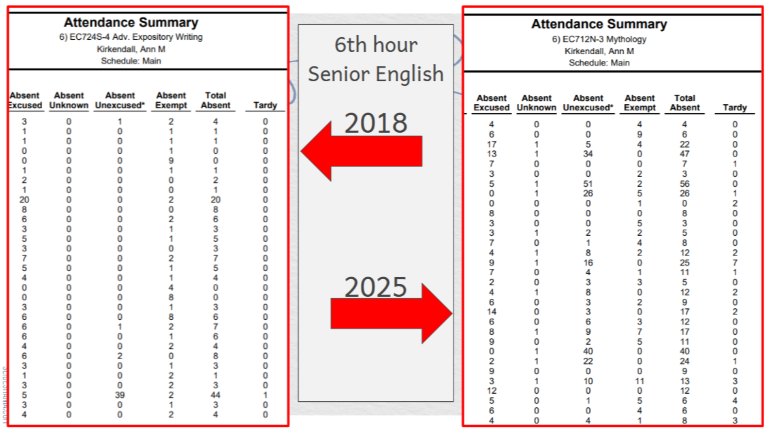On a Tuesday afternoon, Instructor Ann Kirkendall stood in front of her mythology class and counted seven empty chairs. “That’s almost a third of the class,” she muttered to herself before starting a discussion about a chapter of the book that half of the students wouldn’t be there to hear. On the second floor, Instructor Megan Wills had postponed a group project again because too many students were missing. In the front office, Secretary Elianna Garcia was already logging dozens of absence calls, many with familiar reasons: “overslept,” “doctor’s appointment,” “not feeling well.”
Across West Ottawa Public Schools, from kindergarten classrooms to high school hallways, student absenteeism has quietly grown into one of the most persistent and disruptive challenges. While reasons vary, most absences stem from one primary cause: disengagement, which disrupts learning and damages classroom dynamics.
“Attendance is a huge problem that affects both teachers and students,” Instructor Heather Thomas said. “Teachers have plans for their class, and group work doesn’t necessarily happen the way they expect. For students, it’s challenging because they miss important information, and then they’re constantly needing to get caught up.”
Students are aware of these difficulties. “I fall behind in my classes due to missing school, and it’s hard to stay focused when I don’t know what’s going on,” Jr. Saylor VanderWal said. “I go home a lot of the time due to not feeling well because of a few health issues going on right now.”
“My learning has been disrupted a bit by not being at school, not always knowing what’s going on in class, and having missed work. The main cause of missing school is my mental health, and waking up in the morning is not easy. When I am at home, I make sure to check Google Classroom and get the missing work done that I can,” Frosh. Liliana Lara said.
Not all students come from school systems that offer online tools to help them catch up on missed work. Lisa Fromm, a sophomore exchange student, came to West Ottawa and has experienced the differences between schools in the United States and Germany.
“In my school, the teacher calls your name at the beginning of class and marks you as present when you say you’re here. Absences are not very common because people are scared of missing something in school. We don’t have online portals like Google Classroom to check what we did on that day. They expect you to have all the work done by the time you come back to school. Normally, you can ask your friends or email the teacher, but teachers don’t really check in on you if you keep up with your work. That’s why everyone always comes to school, because we don’t have Infinite Campus to check what’s missing. We see the surprise of our grades at the end of the year when they’re locked in,” Fromm said.
Her experience highlights how limited reliance on technology can lead to better attendance habits. In contrast, in the United States, flexible digital tools may unintentionally make it easier for students to disconnect, skip school, or fall behind.
Staff across the district say absenteeism isn’t just about skipping class. It affects students of all ages and often reflects deeper disconnection from school routines, relationships, or goals.
“I think attendance varies a lot by class. On any given day, Class X might have ten students absent, while Class Y may have only one student absent on the same day. In classes with poor attendance, the days that are break-adjacent are probably the worst,” Kirkendall said.
Teachers emphasize that when students are absent, they miss out on more than just lecture notes; they lose valuable experiences that cannot be replicated on paper. Additionally, students forfeit the opportunity for social-emotional learning, which is essential at every stage of development.
“Generally, students tend to say that they were sick. There is so much learning that simply can’t be made up on one’s own. When I think about a class like AP Literature, so much learning happens during discussion. In a class like Mythology, which is more lecture-based, absent students miss a significant amount of content. My lecture and explanation are far more memorable and make more sense than copying a classmate’s notes,” Kirkendall said.
Chronic absenteeism doesn’t just affect the students who miss class; it changes the learning environment for everyone. “It does affect the classroom dynamics. When one group of students chooses not to take a class seriously (which is often how chronic absenteeism is perceived), that gives permission structure to other students also not to take a class seriously; there is a negative ripple effect in terms of academic performance and behavior,” Kirkendall said.
“I think absenteeism is one of the biggest problems in public schools today. I wish there were a magic fix for it, but I don’t think it’s a very simple issue to solve. I think there are a lot of things that cause absenteeism,” Wills said.
Addressing absenteeism means understanding the various factors at play, including students’ personal lives, their mental health, and the learning environment. By recognizing these challenges, educators can develop strategies that promote better attendance.
“I think one of the things that we could do is work on building stronger relationships between teachers and students. Hopefully, then students would feel more comfortable talking to teachers about why they might be absent,” Wills said.
Front office staff have witnessed firsthand how patterns of absenteeism have evolved, both in terms of timing and cause. “Absences tend to spike early in the morning and again in the afternoon. We also see it right before and after breaks, sometimes due to extended vacations, other times because of weather delays,” receptionist Amy Johnson said.
Many chronic absences are rooted in home challenges. “Some students simply have no motivation to come to school, while others are dealing with unstable living conditions or can’t afford basic needs like showers or food. These aren’t always things students can control,” Garcia said.
The pandemic also reshaped student attitudes. “Since COVID, there’s been a noticeable change in how students view school attendance, like it doesn’t matter as much anymore,” attendance secretary Lisa Kephart said.
Technology adds another layer to the rising issue of absenteeism. “Smartphones can keep students entertained all day, but they also feed anxiety. Sometimes that anxiety leads students to avoid school entirely,” Kephart said.
Although attendance policies, including robocalls, warning letters, and meetings with administrators, are in place, many educators believe they have little impact on student attendance. “If anything, I think the school’s policies on attendance are incredibly relaxed. Is there a job where a worker can not show up 15% of the time and stay employed?” Kirkendall said.
“The policies are fair and enforced, but don’t seem to make a difference. Students who don’t want to be here and don’t have support from home just don’t come. The threat of not getting credit for a course does not affect someone who doesn’t care about getting credit,” Johnson said.
Despite the challenges, the school remains committed to supporting students and their families who face barriers to attending school. “We try our very best to keep our students in school. Our goal is always for them to be in a safe environment and graduate,” Garcia said.
Some teachers continue to stay hopeful. “I think bringing in guest speakers or former students to talk about how important it is to be at school could be effective. Especially if those speakers are former students who failed to show up, and how it has affected them,” Instructor Katie Avink said.
However, it’s now a problem that extends beyond West Ottawa. “These culture-wide problems are not issues that we, as a school district, are going to be able to solve on our own. It is going to take a level of awareness and cooperation from students and their parents, as well as societal pressure from whole communities, to change this trajectory,” Kephart said.
“Ultimately, as this is my first year at any school, I am new to this. I think we are doing amazingly well, given the circumstances we’ve been given. The world is ever-changing, and WO is doing our best to work with parents on having their child here and learning,” Garcia said.
Chronic absenteeism won’t be fixed overnight. The causes of disengagement, along with the two key harms, lost learning and classroom disruption, make it a problem that no school can afford to ignore. However, with continued support, compassion, and community effort, educators across the district remain committed to helping students show up, stay engaged, and succeed, one day at a time.







